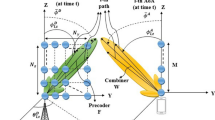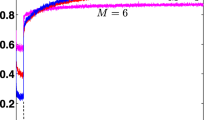Abstract
In this paper, a novel robust adaptive beamforming is proposed in which both the uncertainties of steering vector and covariance matrix are taken into account. First we develop a min–max optimization problem which aims to find a steering vector with the maximum output power under the worst-case covariance mismatch. Then we relax this min–max optimization problem to a max–min optimization problem which can be solved by using the Karush–Kuhn–Tucker optimality conditions. It is also shown that the proposed technique can be interpreted in terms of variable diagonal loading where the optimal loading factors are related to both the correlations (between the eigenvectors and the signal of interest) and the eigenvalues of the data covariance matrix. The effectiveness of the proposed approach is supported by computer simulation results.








Similar content being viewed by others
References
Gu, Y., & Leshem, A. (2012). Robust adaptive beamforming based on interference covariance matrix reconstruction and steering vector estimation. IEEE Transactions on Signal Processing, 60(7), 3881–3885.
Li, J., & Stoica, P. (2005). Robust adaptive beamforming. New York: Wiley.
Vorobyov, S. A. (2013). Principles of minimum variance robust adaptive beamforming design. Signal Processing, 93(12), 3264–3277.
Khabbazibasmenj, A., & Vorobyov, S. A. (2012). Robust adaptive beamforming based on steering vector estimation with as little as possible prior information. IEEE Transactions on Signal Processing, 60(6), 2974–2987.
Landau, L., de Lamare, R. C., & Haardt, M. (2012). Robust adaptive beamforming algorithms based on the constrained constant modulus criterion. http://arxiv.org/abs/1310.0101.
Vorobyov, S. A., Gershman, A. B., & Luo, Z.-Q. (2003). Robust adaptive beamforming using worst-case performance optimization: A solution to the signal mismatch problem. IEEE Transactions on Signal Processing, 51(2), 313–324.
Lorenz, R. G., & Boyd, S. P. (2005). Robust minimum variance beamforming. IEEE Transactions on Signal Processing, 53(5), 1684–1696.
Chen, C.-Y., & Vaidyanathan, P. P. (2007). Quadratically constrained beamforming robust against direction-of-arrival mismatch. IEEE Transactions on Signal Processing, 55(8), 4139–4150.
Cox, H., Zeskind, R., & Owen, M. (1987). Robust adaptive beamforming. IEEE Transactions on Acoustics, Speech and Signal Processing, 35(10), 1365–1376.
Yu, Z.-L., Ser, W., Er, M.-H., Gu, Z., & Li, Y. (2009). Robust adaptive beamformers based on worst-case optimization and constraints on magnitude response. IEEE Transactions on Signal Processing, 57(7), 2615–2628.
Kim, S.-J., Magnani, A., Mutapcic, A., Boyd, S. P., & Luo, Z.-Q. (2008). Robust beamforming via worst-case SINR maximization. IEEE Transactions on Signal Processing, 56(4), 1539–1547.
Lie, J.-P., Ser, W., & See, C.-M. S. (2011). Adaptive uncertainty based iterative robust capon beamformer using steering vector mismatch estimation. IEEE Transactions on Signal Processing, 59(9), 4483–4488.
Jin, W., Jia, W., Zhang, F., & Yao, M. (2014). A user parameter-free robust adaptive beamformer based on general linear combination in Tandem with steering vector estimation. Wireless Personal Communications, 75, 1447–1462.
Zhuang, J., & Huang, P. (2012). Robust adaptive array beamforming with subspace steering vector uncertainties. IEEE Signal Processing Letters, 19(12), 785–788.
Zhang, W., Wang, J., & Wu, S. (2013). Robust Capon beamforming against large DOA mismatch. Signal Processing, 93(4), 804–810.
Zhuang, J., & Manikas, A. (2013). Interference cancellation beamforming robust to pointing errors. IET Signal Processing, 7(2), 120–127.
Li, J., Stoica, P., & Wang, Z. S. (2003). On robust Capon beamforming and diagonal loading. IEEE Transactions on Signal Processing, 51(7), 1702–1715.
Gu, Y. J., Zhu, W. P., & Swamy, M. N. S. (2010). Adaptive beamforming with joint robustness against covariance matrix uncertainty and signal steering vector mismatch. Electronics Letters, 46(1), 86–88.
Feldman, D. D., & Griffiths, L. J. (1994). A projection approach to robust adaptive beamforming. IEEE Transactions on Signal Processing, 42(4), 867–876.
Shahbazpanahi, S., Gershman, A. B., Luo, Z.-Q., & Wong, K. M. (2003). Robust adaptive beamforming for general-rank signal models. IEEE Transactions on Signal Processing, 51(9), 2257–2269.
Vorobyov, S. A., Gershman, A. B., Luo, Z.-Q., & Ma, N. (2004). Adaptive beamforming with joint robustness against mismatched signal steering vector and interference nonstationarity. IEEE Signal Processing Letters, 11(2), 108–111.
M. Grant, S. Boyd. (2013) CVX: Matlab software for disciplined convex programming, version 2.0 beta. http://cvxr.com/cvx.
Song, X., Wang, J., & Wang, B. (2010). Robust adaptive beamforming under quadratic constraint with recursive method implementation. Wireless Personal Communications, 53, 555–568.
Du, L., Li, J., & Stoica, P. (2010). Fully automatic computation of DIagonal loading levels for robust adaptive beamforming. IEEE Transactions on Aerospace and Electronic Systems, 46(1), 449–458.
Hassanien, A., Vorobyov, S. A., & Wong, K. M. (2008). Robust adaptive beamforming using sequential quadratic programming: An iterative solution to the mismatch problem. IEEE Signal Processing Letters, 15(11), 773–736.
Boyd, S., & Vandenberghe, L. (2004). Convex optimization. Cambridge: Cambridge University Press.
Abdel-Samad, A., Davidson, T. N., & Gershman, A. B. (2006). Robust transmit eigen beamforming based on imperfect channel state information. IEEE Transactions on Signal Processing, 54(5), 1596–1609.
Acknowledgments
This work was supported by the open research fund of Chongqing Key Laboratory of Emergency Communications under Grant No. CQKLEC20130504, the Fundamental Research Funds for the Central Universities under Grant No. ZYGX2014J007, the Scientific Research Foundation for the Returned Overseas Chinese Scholars (SRF for ROCS, SEM) under Grant No. LXHG-47-ZJ, the National Natural Science Foundation of China under Grant No. 61301272, the Program for New Century Excellent Talents in University under Grant No. NCET-11-0873, the Program for Innovative Research Team in University of Chongqing under Grant No. KJTD201343, the Key Project of Chongqing Natural Science Foundation under Grant No. CSTC2011BA2016.
Author information
Authors and Affiliations
Corresponding author
Appendix: Proof of (24)
Appendix: Proof of (24)
Let us start with the equation
Differentiating with respect to \(\beta _i\), we have
where \(\delta (i)\) is the impulse function. Therefore,
Using (22) and differentiating it with respect to \(\beta _i\), we have
Substituting \(\frac{\partial {\uplambda }}{\partial \beta _i}\) from (33), we have
which is equivalent to (24).
Rights and permissions
About this article
Cite this article
Zhuang, J., Zhang, T., Chen, J. et al. A Variable Diagonal Loading Beamformer with Joint Uncertainties of Steering Vector and Covariance Matrix. Wireless Pers Commun 84, 999–1015 (2015). https://doi.org/10.1007/s11277-015-2672-z
Published:
Issue Date:
DOI: https://doi.org/10.1007/s11277-015-2672-z




